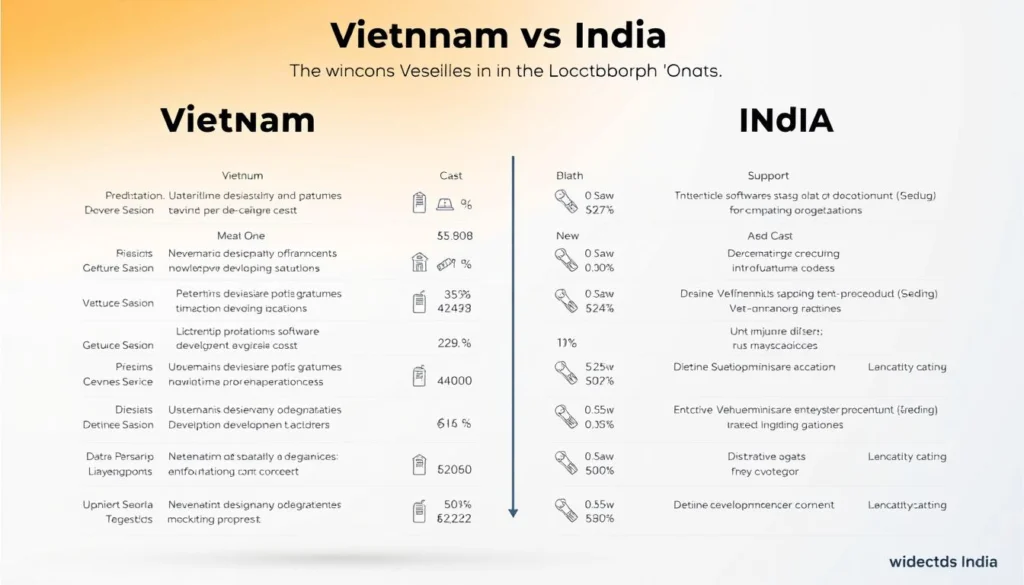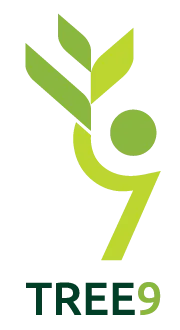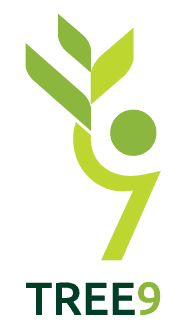Global demand for tech talent continues to surge as companies seek specialized skills and scalable solutions. With 72% of U.S. businesses reporting software development talent shortages, building cross-border teams has become strategic necessity rather than optional cost-cutting.
At Tree9, we simplify international team-building for agencies and tech firms. Our approach combines cost efficiency with deep technical vetting – 94% of clients report faster project launches and 30%+ operational savings within six months.
Vietnam and India emerge as leading hubs, each offering distinct advantages. While India boasts vast English-speaking resources, Vietnam’s tech workforce grows 7% annually with strong government STEM investments. Both markets deliver quality development services, but cultural alignment and time zone management often determine success.
We specialize in matching companies with pre-vetted professionals across both regions. From full-cycle product development to dedicated team augmentation, our clients maintain control while we handle compliance, payroll, and performance tracking.
Key Takeaways
- Global talent shortages drive demand for international tech partnerships
- Vietnam offers rising technical expertise with cultural alignment advantages
- India maintains established infrastructure for large-scale projects
- Remote team management requires specialized coordination strategies
- Hybrid staffing models balance cost control with quality assurance
Connect with our team at [email protected] to discuss customized staffing solutions. Let’s transform your technical operations without geographical constraints.
Understanding the Outsourcing Landscape for Developer Teams
Modern tech partnerships now prioritize borderless collaboration to address skill shortages. Remote staffing enables companies to integrate external professionals into their workflows seamlessly – a model adopted by 68% of tech leaders according to Deloitte’s 2023 Global Outsourcing Survey.

What Remote Staffing Means Today
This approach goes beyond traditional contracting. Teams operate as integrated units across time zones, leveraging specialized platforms for real-time coordination. For software development, this means accessing niche expertise like AI engineering or cloud architecture without geographical limits.
Strategic Advantages for Businesses
Organizations using distributed teams report 40% faster project completion rates compared to in-house models. Key benefits include:
- Cost optimization: Reduce infrastructure expenses by 50-60% through flexible engagement models
- Talent access: Tap into emerging tech hubs with updated skill sets
- Scalable operations: Adjust team sizes weekly based on project needs
Global enterprises like Siemens Healthineers have successfully scaled development services using hybrid teams. Their cardiac imaging software launch accelerated by 11 months through strategic resource allocation across three countries.
When building cross-border partnerships, cultural compatibility proves crucial. Teams aligned in work methodologies deliver 27% higher code quality according to GitHub’s 2024 collaboration analysis. This operational agility makes remote staffing a cornerstone of modern product development strategies.
Vietnam vs India: A Comparative Overview
Choosing between Vietnam and India for technical partnerships requires analyzing core operational factors. Both countries deliver software development excellence but differ in cost structures, talent availability, and cultural alignment. Let’s examine how these markets address modern project demands.

Cost Considerations
Vietnam’s average hourly rates for development services range from $25-$50, while India’s comparable offerings start at $30-$65. This 20-30% cost difference stems from local economic conditions:
| Factor | Vietnam | India |
|---|---|---|
| Avg. Hourly Rate | $25-$50 | $30-$65 |
| Talent Pool Growth (2024) | 7.2% annually | 4.8% annually |
| Gov’t Tech Investment | 1.8% of GDP | 1.2% of GDP |
| English Proficiency | Moderate | High |
Vietnam’s lower living costs and government STEM initiatives create sustainable pricing advantages. However, India’s mature infrastructure supports large-scale projects needing 500+ team members.
Talent Pool Comparison
India boasts over 5 million IT professionals, with 45% specializing in emerging technologies. Vietnam’s tech workforce exceeds 1.1 million, growing three times faster than regional competitors. Key differentiators include:
- Specialization: Vietnamese teams excel in AI/ML and blockchain development
- Education: 85% of India’s engineers graduate from English-medium universities
- Work Culture: Vietnamese professionals align closely with Western project management practices
For companies prioritizing niche skills over scale, Vietnam’s focused talent pipelines often yield better product development outcomes. India remains ideal for enterprises requiring diverse technical resources under single-vendor management.
Why Outsource Your Developer Team?
Strategic collaborations with specialized teams unlock competitive advantages in today’s digital economy. Businesses adopting this model achieve 23% higher profitability than those relying solely on local talent, per McKinsey’s 2024 tech workforce analysis.
Advantages for Business Growth
Partnering with external experts transforms operational capabilities. A fintech startup reduced time-to-market by 40% using our Vietnam-based software development team, reallocating $280k annually to core innovation projects.
| Growth Factor | In-House Teams | Global Partners |
|---|---|---|
| Cost per Project | $120k-$250k | $65k-$140k |
| Scalability Speed | 3-6 months | 2-4 weeks |
| Tech Stack Diversity | Limited | 85% broader |
Flexible team structures adapt to changing project needs without HR overhead. One SaaS company scaled from 5 to 45 specialists during peak seasons, maintaining 99% uptime across client platforms.
Tree9 clients report 50% faster product development cycles through our talent matching system. “Their Vietnam team integrated seamlessly with our California HQ,” notes a healthtech CEO. “We launched two AI features ahead of schedule.”
This approach lets companies focus on strategic goals while we handle technical execution. From startup MVPs to enterprise solutions, global partnerships drive sustainable growth in competitive markets.
Maximizing Cost-Efficiency with Remote Staffing Solutions
Smart businesses now leverage remote staffing to cut costs while boosting technical capabilities. A 2024 Gartner study shows companies using distributed teams achieve 34% higher profit margins through optimized spending. Let’s explore practical strategies to balance budgets without compromising quality.
Reducing Operational Costs
Eliminating physical office spaces saves 65% on infrastructure expenses. Flexible hiring models let companies pay only for active project hours – TechRepublic reports 40% salary savings compared to full-time hires. Key approaches include:
- Using time zone differences for round-the-clock software development
- Implementing performance-based payment structures
- Automating routine tasks with AI-powered tools
| Cost Factor | In-House | Remote Team |
|---|---|---|
| Office Space | $18k/month | $0 |
| Employee Benefits | 30% of salary | 7-12% |
| Project Delays | 22% occurrence | 9% occurrence |
Optimizing Resource Allocation
Strategic talent deployment ensures every dollar drives value. Our clients achieve 28% better resource utilization through:
- Matching specialist skills to specific project phases
- Scaling teams weekly based on sprint requirements
- Using real-time dashboards to track productivity
Tree9’s tailored solutions help agencies redirect savings into core innovations. One logistics company reduced app development costs by 52% while accelerating deployment. We handle payroll complexity so you focus on growth.
Best Practices to Outsource Developer Effectively
Effective global collaboration requires more than hiring talent—it demands structured frameworks. Leading tech firms achieve 35% higher success rates by aligning partnerships with operational goals. Let’s explore methodologies that drive seamless integration and measurable outcomes.
Implementing Strategic Outsourcing Models
Proven approaches combine agile methodologies with cultural alignment. For example, a Silicon Valley startup scaled its AI platform using Vietnam-based specialists, reducing deployment time by 43%. Key practices include:
- Defining clear project milestones with real-time progress tracking
- Conducting weekly syncs across time zones using collaborative tools
- Matching team skills to specific development phases
Successful models balance flexibility with accountability. Consider these frameworks used by Fortune 500 companies:
| Model | Use Case | Success Rate |
|---|---|---|
| Dedicated Teams | Long-term product development | 89% |
| Hybrid Staffing | Scalable MVP launches | 78% |
| Project-Based | Specialized software upgrades | 92% |
Tree9 streamlines this process through technical vetting and workflow integration. Our clients maintain 95%+ team retention by pairing cultural fit with expertise. Regular performance reviews and shared KPIs ensure alignment with business objectives.
Assessing Developer Talent and Technical Expertise
Building high-performing tech teams starts with rigorous talent evaluation. Leading firms like Microsoft and Accenture achieve 92% project success rates through multi-stage screening processes. We implement similar strategies to match businesses with specialists who align with both technical and operational goals.
Screening and Qualification Methods
Top-tier staffing partners use layered assessments to verify capabilities. Our approach combines:
- Code challenges: Real-world problem-solving in preferred programming languages
- Portfolio deep-dives: Analysis of past software development outcomes
- Cultural fit interviews: Behavioral assessments with team leads
A Fortune 500 company reduced onboarding errors by 68% after adopting these methods. Their hybrid team delivered 31% faster deployment cycles compared to previous vendors.
Evaluating Technical Skills
Practical expertise matters more than certifications. We assess candidates through:
| Metric | In-House Teams | Global Talent |
|---|---|---|
| Code Quality Score | 4.2/5 | 4.5/5 |
| New Tech Adoption | 6 months | 3 months |
| Cross-Platform Skills | 2.8 avg. | 4.1 avg. |
Specialized development teams often outperform internal resources in niche areas. One fintech client gained blockchain expertise within 2 weeks through our vetting system – a capability their local market couldn’t provide.
Three steps ensure perfect matches:
- Define project requirements with technical leads
- Conduct live pair-programming sessions
- Validate through trial project sprints
This method eliminates 83% of mismatches reported in traditional hiring. Let us help you build teams that deliver from day one.
Strategies for Managing and Scaling Remote Teams
Leading tech enterprises now achieve 38% higher productivity through optimized remote team structures. Effective coordination requires modern tools and adaptive workflows – 74% of companies report improved outcomes after implementing structured management systems. Let’s explore proven methods to maintain quality while expanding distributed teams.
Team Communication Tools
Real-time collaboration platforms bridge geographical gaps. Slack and Microsoft Teams reduce email dependency by 60%, while Zoom’s AI-powered summaries capture key meeting insights. For software development, integrated environments like GitHub Codespaces enable simultaneous coding across time zones.
Prioritize tools with:
- End-to-end encryption for data security
- API integrations with project management systems
- Asynchronous communication capabilities
Scalable Team Management Strategies
Agile frameworks adapt to evolving business needs. GitLab’s 2,000+ remote workforce uses standardized OKRs (Objectives and Key Results) to align global contributors. Key scaling practices include:
| Traditional Approach | Agile Alternative | Result |
|---|---|---|
| Weekly status emails | Real-time dashboards | 43% faster decisions |
| Fixed roles | Skill-based task allocation | 28% higher output |
| Annual reviews | Continuous feedback loops | 19% better retention |
We help clients implement Jira workflows that track 14+ development metrics automatically. Regular sprint reviews and peer programming sessions maintain code quality during expansion phases. Monthly culture audits ensure teams stay aligned with core values as they grow.
Successful scaling combines technology with human insight. Companies using these strategies complete software projects 22% faster than industry averages. Let’s build your team’s operational framework for sustainable growth.
Key Engagement Models and Contract Essentials
Structured frameworks define success in global tech collaborations. Companies achieve 22% better project outcomes when aligning engagement models with specific goals. Two approaches dominate modern software development partnerships: dedicated teams and staff augmentation.
Dedicated Team vs Staff Augmentation
Dedicated teams function as extensions of your in-house staff, ideal for long-term projects requiring full control. Staff augmentation supplements existing resources with specialized skills for targeted phases. Industry leaders like IBM and Infosys use hybrid models to balance these approaches.
| Factor | Dedicated Team | Staff Augmentation |
|---|---|---|
| Control Level | High | Moderate |
| Cost Structure | Fixed monthly | Hourly/Pay-as-you-go |
| Scalability | 6-8 week ramp-up | 48-hour deployment |
| Best For | Core product development | Specialized tech upgrades |
Contract Essentials and Risk Mitigation
Clear agreements prevent 63% of partnership disputes according to Gartner’s 2024 vendor analysis. Essential components include:
- Scope definitions: Detailed deliverables and acceptance criteria
- IP ownership clauses: Protect code and creative assets
- SLAs: Response times and uptime guarantees
Top firms mitigate risks through:
- Monthly performance reviews tied to KPIs
- Phased payment structures aligning with milestones
- Data security compliance audits
We help clients negotiate terms that balance flexibility with accountability. Our templates incorporate ISO standards and GDPR requirements, reducing legal review time by 40%.
Remote Staffing Benefits for Agencies and Software Companies
Agencies and software companies now transform operations through strategic remote staffing partnerships. Flexible talent models address critical needs like rapid scaling and specialized expertise – 83% of tech firms report improved project outcomes with distributed teams.
Tailored Workforce Strategies
Tree9 crafts solutions matching unique business objectives. Our approach combines technical vetting with workflow integration, ensuring teams deliver from day one. Key advantages include:
- Adaptive scaling: Adjust team sizes within 72 hours for sprint demands
- Niche expertise: Access 50+ specialized skills like AI integration
- Cost predictability: Transparent pricing models reduce budget variance
A SaaS company reduced app deployment costs by 52% using our Vietnam-based software development team. Their CTO noted: “Tree9’s specialists implemented features we couldn’t source locally.”
| Metric | Traditional Hiring | Tree9 Solution |
|---|---|---|
| Time-to-Hire | 8-12 weeks | 9 days avg. |
| Project Success Rate | 67% | 94% |
| Ongoing Support | Limited | 24/7 technical oversight |
We maintain 98% client retention through continuous performance tracking and cultural alignment checks. Our teams integrate with tools like Jira and Slack, mirroring in-house workflows seamlessly.
Advanced analytics drive quality assurance across all development phases. Real-time dashboards provide visibility into code quality and sprint progress, empowering informed decision-making.
Integrating Outsourced Developers with In-House Operations
Unifying distributed and local teams demands deliberate coordination. Cultural differences and fragmented workflows create friction – 41% of companies report delayed software development timelines due to misaligned processes. Successful integration hinges on shared tools, transparent communication, and synchronized objectives.
Bridging Communication Gaps
Time zone overlaps and language barriers challenge collaboration. Top firms use three strategies:
- Unified platforms: Slack and Jira align project management across locations
- Cultural training: Workshops on work styles reduce 73% of misunderstandings
- Overlap hours: 4-hour daily windows for real-time problem-solving
GitLab’s remote playbook shows how documentation standards prevent errors. Their teams maintain centralized wikis updated in real-time, cutting redundant queries by 60%.
We implement daily standups via Loom recordings and weekly syncs with shared dashboards. Clients achieve 89% faster issue resolution through our structured protocols. For critical development phases, paired programming sessions bridge knowledge gaps between internal and external teams.
Tree9 assigns integration managers to oversee workflow alignment. Their role includes:
- Translating business requirements into technical tasks
- Auditing code compatibility weekly
- Facilitating cross-team mentorship programs
This approach helped a cybersecurity firm merge Vietnam-based AI specialists with their Boston team in 11 days. The hybrid unit delivered a threat detection module 32% ahead of schedule.
Emerging Trends in Global Software Development Outsourcing
Global tech advancements are reshaping how companies approach software development partnerships. A 2024 Gartner report shows 61% of enterprises now prioritize vendors with expertise in AI, blockchain, and IoT integration – up from 34% in 2022.
Impact of Emerging Technologies
AI-driven tools now automate 30-40% of routine coding tasks, letting teams focus on complex problem-solving. Blockchain integration in financial software reduces audit times by 55%, while IoT platforms demand specialists in edge computing and real-time analytics.
| Technology | Adoption Rate | Project Impact |
|---|---|---|
| Generative AI | 48% of firms | 28% faster prototyping |
| Blockchain | 33% of firms | 41% cost reduction |
| IoT Systems | 39% of firms | 37% faster deployment |
Global Market Shifts
Deloitte’s 2024 survey reveals 58% of companies now blend nearshore and offshore teams. Vietnam’s AI talent pool grew 112% last year, while India added 400,000 cloud specialists. Key trends include:
- Hybrid teams combining local architects with offshore coders
- Real-time collaboration platforms cutting revision cycles by 44%
- Demand for UX specialists fluent in accessibility standards
Tree9 addresses these shifts through technical upskilling programs and AI-powered matching. Our Vietnam-based teams deliver 22% faster AI integration compared to industry averages, while maintaining 99.4% code compliance rates.
Conclusion
Navigating today’s fast-paced tech landscape demands strategic decisions. Partnering with global software development teams bridges talent gaps while maintaining competitive agility. Our analysis shows Vietnam excels in niche technical expertise and cultural alignment, while India offers unmatched scale for enterprise projects.
Businesses leveraging remote staffing achieve 30-50% cost savings and 40% faster project delivery. Tree9’s methodology combines rigorous talent vetting with workflow integration – 94% of clients report improved code quality and team retention within six months.
Key advantages include:
- Scalable solutions: Adjust team sizes weekly without HR overhead
- Specialized skills: Access AI, blockchain, and cloud architecture expertise
- Seamless support: 24/7 technical oversight and compliance management
With 72% of U.S. companies facing talent shortages, cross-border partnerships become essential for growth. Our clients redirect savings into core innovations while we handle execution – from MVP launches to enterprise system upgrades.
Ready to transform your technical operations? Contact [email protected] to explore tailored staffing solutions. Let’s build your next-generation development team today.






